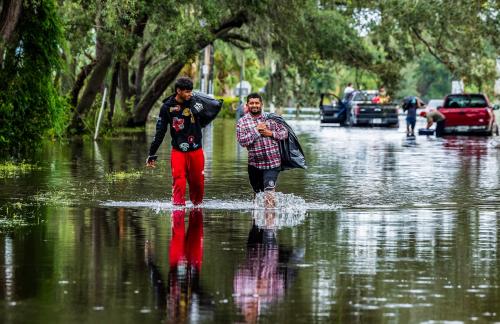ABSTRACT
Using random year-to-year variation in temperature, we document
the relationship between daily temperatures and annual mortality
rates and daily temperatures and annual residential energy consumption.
Both relationships exhibit nonlinearities, with significant
increases at the extremes of the temperature distribution. The application
of these results to “business as usual” climate predictions
indicates that by the end of the century climate change will lead to
increases of 3 percent in the age-adjusted mortality rate and 11 percent
in annual residential energy consumption. These estimates likely
overstate the long-run costs, because climate change will unfold
gradually allowing individuals to engage in a wider set of adaptations.
INTRODUCTION
The climate is a key ingredient in the earth’s complex system that sustains human life and well-being. There is a growing consensus that emissions of greenhouse gases due to human activity will alter the earth’s climate, most notably by causing temperatures, precipitation levels, and weather variability to increase (Intergovernmental Panel on Climate Change (IPCC) 2007). The development of rational policies requires estimates of the costs associated with these changes in our planet.
Integrated Assessment Models (IAMs) are a popular method to model the costs of climate change. IAMs combine general circulation models of climate and computable general equilibrium economic models to determine the interrelationship between climate and economic activity and policies that affect both of them. An appealing feature of these models is that they allow for a wide range of adaptations by agents in response to changes in relative prices and climate. Additionally, and perhaps even more importantly, they produce an overall estimate of the impact of climate change or climate change mitigation policies on welfare.
The weakness with IAMs is that inside their black box they can rely on hundreds of parameter estimates. Consequently, the source of the results is unclear, and any notion of uncertainty requires treating many or most of these parameters as known constants. In addition, there is substantial model uncertainty, which is difficult to quantify and rarely reflected in the estimates. Indeed, the Stern Report writes that IAMs are “a computationally demanding exercise, with the result that such models make drastic, often heroic, simplification along all stages of the climate-change chain. What is more, large uncertainties are associated with each element in the cycle” (Stern 2007, 145).
This paper takes a radically different approach than the one used by IAMs to learn about the costs that climate change will impose. Its starting point is that massive historical datasets and transparent statistical models can complement IAMs and even help to improve them. According to the IPCC, human health is a primary channel through which climate change will affect human welfare, yet little is known about the likely impacts (IPCC 2007; World Health Organization (WHO) 2003). Consequently, our focus in this paper is to develop new estimates of the imPact of climate change on human health.
The paper’s conceptual framework is derived from the canonical Becker- Grossman models of health production (Michael Grossman 2000). Specifically, we estimate the impacts of climate change on mortality and expenditures on self-protection or adaptation to learn about the impacts of climate change. Our measure of self-protection is energy consumption, which via air conditioning is perhaps the primary form of protection against high temperatures. The identification strategy relies on the unpredictable and presumably random year-to-year local variation in temperature, so concerns about omitted variables bias are unlikely to be important.
We find a statistically significant relationship between mortality and daily temperatures in the United States, where extremely cold and hot days are associated with elevated mortality rates. However, the magnitude of these effects is smaller than what is suggested by the conventional wisdom based on high profile heat waves (see, e.g., Eric Klinenberg 2002). For example, we find that an additional day with a mean temperature exceeding 90° F, relative to a day in the 50°– 60° F range, leads to an increase in the annual age-adjusted mortality rate of about 0.11 percent. Similarly, a day with a mean temperature below 20° F is associated with an increase in annual mortality of roughly 0.07–0.08 percent. The finding about temperatures and mortality is robust to a wide variety of specification tests and is more pronounced for infants and the elderly. Additionally, there is substantial heterogeneity in the responses to extreme temperatures across the country, although it appears unrelated to baseline temperatures or climate.
We also find a nonlinear relationship between annual energy consumption and daily temperature, where energy consumption is elevated in response to temperature- days at the two extremes of the distribution. In particular, there is a proportionally larger increase in energy usage on days where the temperature exceeds 90° F; one extra such day, relative to a day in the 50°–60° F range, leads to a 0.4 percent increase in annual consumption. The comparable estimate for a day below 20° F is an increase of roughly 0.2 percent–0.3 percent. There is geographic heterogeneity in these responses to extreme temperatures but it appears unrelated to current climate. However, it seems plausible to conclude that the weaker mortality-temperature relationship is at least partially due to the self-protection provided by the cooling from increased energy consumption.
We then combine these estimated relationships with predicted changes in climate from state of the art climate models and “business as usual” scenarios to develop estimates of the health related welfare costs of climate change in the United States. The preferred estimates suggest that climate change will lead to an increase in the age adjusted U.S. mortality rate of 3 percent by the end of the twenty-first century. To put this in context, the age-adjusted mortality rate has declined by roughly 1 percent per year over the last 35 years, so this appears to be a small effect. In contrast, the energy results suggest that climate change will cause annual U.S. residential energy consumption to increase by up to 11 percent at the end of the century. Taken together, the present discounted values of the losses due to increased mortality and energy consumption over the remainder of the century range from 10 percent to 58 percent of 2010 GDP, but the null hypothesis of a zero loss cannot be rejected at conventional significance levels.
The analysis is conducted with detailed and comprehensive data available on mortality, energy consumption, weather, and climate change predictions for fine U.S. geographic units covering the whole continental United States. The mortality data come from more than 73.2 million death certificates in the 1968–2002 Compressed Mortality Files, the energy data are from the Energy Information Administration and the weather data are from the thousands of weather stations located throughout the United States. We utilize two sets of state of the art end-of-century (i.e., 2070–2099) daily climate change predictions that represent “business-as-usual” scenarios.
Finally, the paper’s approach mitigates or solves the conceptual and statistical problems that have plagued previous research (e.g., Francesco Bosello, Roberto Roson, and Richard S. J. Tol 2006, Katharine Hayhoe et al. 2004). First, the availability of data on energy consumption means that we can measure the impact on mortality and self-protection expenditures. Second, the estimation of annual mortality equations, rather than daily ones, mitigates concerns about failing to capture the full mortality impacts of temperature shocks. Third, the use of comprehensive datasets from the entire United States over a 35 year period means that the estimates are externally valid to a wide range of places. Specifically, they are more general than estimates derived from studies of single events in small geographic areas over a small fraction of the temperature distribution (e.g., the impact of the French heat wave) that have been emphasized by the IPCC and Stern Report (IPCC 2007; Stern2007). Fourth, the statistical models include county and state-by-year fixed effects so they adjust for any permanent differences in unobserved health across counties due to sorting while also controlling for differential trends across states. Fifth, we model daily temperature semi-parametrically, so we do not rely on functional form assumptions to infer the impacts of the hottest and coldest days. Finally, we estimate separate mortality models for four age groups, which allows for substantial heterogeneity in the impacts of temperature.
Before proceeding, we emphasize that there are a few important caveats to our effort to estimate the health related welfare impacts of climate change-induced increases in temperature. On the one hand, the estimated impacts likely overstate the mortality and adaptation costs, because the analysis relies on inter-annual variation in weather, and less expensive adaptations will be available in response to permanent climate change. On the other hand, the estimated welfare losses fail to include the impacts on other health-related determinants of welfare (e.g., morbidities and diseases vectors) that may be affected by climate change, so in this sense they are an underestimate. Additionally, the effort to project outcomes at the end of the century requires a number of strong assumptions, including that the climate change predictions are correct, relative prices (e.g., for energy and medical services) will remain constant, the same energy and medical technologies will prevail, and the demographics of the U.S. population (e.g., age structure) and their geographic distribution will remain unchanged. These are strong assumptions, but in contrast to IAMs they allow for a transparent analysis based on data rather than on unverifiable assumptions.
The paper proceeds as follows. Section I briefly reviews the patho-physiological and statistical evidence on the relationship between weather and mortality. Section II provides the conceptual framework for our approach. Section III describes the data sources and reports summary statistics. Section IV presents the econometric approach, and Section V describes the results. Section VI assesses the magnitude of our estimates of the effect of climate change and discusses a number of important caveats to the analysis. Section VII concludes the paper.
The Brookings Institution is committed to quality, independence, and impact.
We are supported by a diverse array of funders. In line with our values and policies, each Brookings publication represents the sole views of its author(s).



Commentary
Climate Change, Mortality, and Adaptation: Evidence from Annual Fluctuations in Weather in the U.S.
October 1, 2011